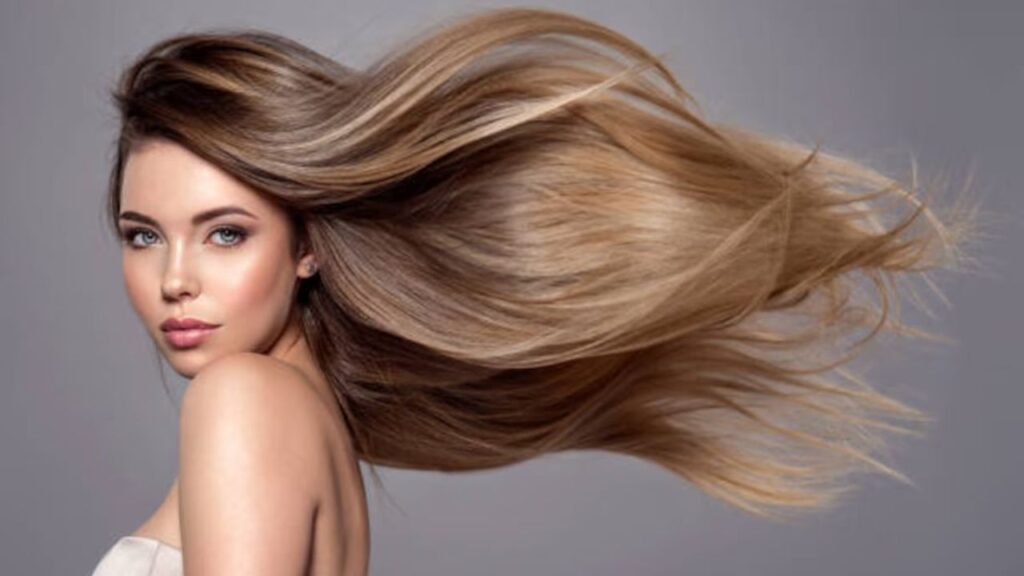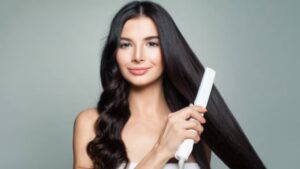
Straight or silky hair often seems like a dream, doesn’t it? Such tresses exude a radiant gloss and are a breeze to manage. Yet, while wavy and curly locks hold their own kind of allure, they demand more TLC (Tender Loving Care). And let’s face it, between our busy lives and other commitments, we might not always have the luxury to indulge in prolonged hair care rituals. Enter: hair smoothing and straightening treatments – modern miracles designed to transform your mane and make those bad hair days a thing of the past. Although both aim to give you with more manageable locks, they are, indeed, different beasts.
A little journey through hair history: Hair straightening made its grand debut before hair smoothing did, with its roots (pun intended!) in addressing African hair types. Originally meant to tame and straighten dense, frizzy locks, it didn’t take long for this treatment to climb the ladder of hair fashion. On the other hand, hair smoothing – often hailed as the Brazilian keratin treatment or the Brazilian blowout – was born in the sun-kissed lands of Brazil in 2003. Beyond their origins, there are several nuances that set these two treatments apart. Fancy a deeper dive? Read on!
Understanding Hair Straightening: A Deep Dive
Hair straightening treatments come in two main varieties: the ephemeral and the eternal. The fleeting, or temporary straightening, often involves the use of heated styling instruments, such as straightening irons or hot combs. Think of it as a temporary truce between your hair’s natural bends and the straight silhouette you’re aiming for. It’s an intricate dance where cohesive and adhesive forces play in unison, ensuring those tresses lay parallel for a time. However, like all good things, this straightness comes to an end with a simple hair wash, bringing back your hair’s inherent texture.
In contrast, permanent hair straightening is like a pact made in stone. This procedure is all about a metamorphosis, transforming your locks to achieve that sleek, pin-straight look. Dive into the science of it, and it’s a mix of potent chemical relaxers working their magic. These chemicals target and disrupt the bonds within your hair, making way for a new order. With the addition of heat, your hair is reshaped, and subsequent chemicals are introduced to cement these new bonds in place. The key player in this transformation is the alkaline agent present in the chemical relaxer. Its primary role is to confront the keratin bonds in curly or wavy hair, stretching and smoothing them to submission.
An interesting side note: A study delved into the hair product habits of African-American women, mapping patterns across different life stages and juxtaposing it with socioeconomic status (SES). Of the 1,555 participants, a whopping 89% admitted to using chemical relaxers or straighteners at some point. The frequency peaked during adolescence and waned in adulthood. The study underscored the importance of understanding intricate patterns of hair product usage, emphasising that it’s not just a black-and-white scenario of use or no use. Notably, one’s SES often influenced the diversity and frequency of products used, shedding light on the nuanced relationship between hair care and socio-economic factors.
Decoding Hair Treatments: Straightening vs. Smoothing
Navigating the world of hair treatments can be a maze. With the array of options out there, understanding the processes, benefits, and potential drawbacks is crucial. Let’s delve deep into the realms of hair straightening and smoothing, simplifying the jargon and presenting the facts.
Hair Straightening Unveiled:
How Does It Operate?
Alkaline straighteners boast ingredients such as sodium hydroxide, lithium hydroxide, or calcium hydroxide, ranging from 1-10%. Their high pH opens up the cuticle scales, delving into the hair fibres. Upon meeting the cortex, these chemicals tangle with keratin, restructuring the disulfide bridges. The result? Hair that’s seamlessly straightened.
The Good and the Not-so-good:
This method offers a transformative experience, especially for those with incredibly curly hair. Yet, the quest for perpetual straightness comes with its set of pitfalls, including scalp burns, hair fragility, frizziness, dandruff, and even hair loss, among others.
When Is It Apt for You?
Almost universal in its appeal, hair straighteners cater to varied hair types. But remember, the frequency of sessions depends on your hair’s natural texture. A word of caution for the bleach lovers – the chemicals used in straightening don’t play well with bleached hair.
The Essence of Hair Smoothing:
The Basics:
Often dubbed a milder sibling of hair straightening, hair smoothing lends a temporary makeover. Its forte lies in enhancing hair manageability and aesthetics. Although less aggressive than its counterpart, it isn’t a one-size-fits-all solution.
The Process, Simplified:
It all begins with a formaldehyde concoction that restructures the keratin molecule’s hydrogen bonds. Once applied, the hair is blow-dried (or flat ironed), with the revamped keratin aligning perfectly, courtesy of the formaldehyde. The outcome? Hair that glistens with shine and feels straighter.
Is This Your Cup of Tea?
If you’re battling with frizzy or wavy hair, this could be your knight in shining armour. However, extremely curly, coarse, or thick hair might need something stronger. With effects lasting up to 5 months, it’s a short-term commitment.
A Heads-up on Side Effects:
While the original Brazilian keratin treatment came under scrutiny for formaldehyde’s side effects, modern iterations use safer alternatives like methylene glycol or glyoxylic acid. Still, it’s wise to be aware of potential reactions, ranging from eye discomfort to respiratory issues.
In the grand battle of straightening vs. smoothing, understanding their intricacies helps you make an informed decision. Whether you’re seeking a permanent transformation or a fleeting dalliance with straight hair, there’s a treatment tailored just for you. Just ensure you’re in the know, and your tresses will thank you!
Choosing Between Hair Smoothing and Hair Straightening: The Ultimate Guide
Embarking on the journey to smooth, frizz-free hair can be a daunting one with choices galore. Here, we’ll assist you in demystifying the conundrum between hair smoothing and hair straightening.
The Allure of Hair Smoothing:
Tailored for Naturalness:
For those who yearn for a natural finish without the ultra-straight look, hair smoothing is your port of call. It’s gentler on the hair, causing less damage, and offers that breezy, frizz-free aesthetic many desire.
Versatility in Application:
Bleached? Dyed? Relaxed? No worries. Hair smoothing caters to a variety of hair types, enhancing both shine and softness without compromising the hair’s integrity.
But Remember:
Though hair straightening indeed subjects hair to a rigorous restructuring process, it can be mended. Yet, such revival calls for rigorous aftercare, especially as your natural hair begins its resurgence.
The Charm of Hair Straightening:
For the Tenacious Tresses:
When the hair is thick, kinky, and rebellious, hair straightening often becomes the preferred choice, especially if pin-straight hair is the dream.
Transcending Smoothing:
While hair smoothing is a marvel for taming frizz, expecting pin-straight results from it would be a tall order. Hair straightening, on the other hand, promises and delivers on that front.
Word to the Wise:
Before venturing into either treatment, ensure a thorough hair test and consultation at your salon. Any discomfort, allergies, or hair issues should be a signal to consult with a medical professional.
The Verdict: Hair Smoothing or Hair Straightening?
Each treatment is potent in its own right, helmed by experienced professionals in the salon setting. They come with their own set of aftercare needs to retain the achieved results.
As you ponder your choice, consider:
The longevity of the results you seek: Permanent vs. Temporary.
The finish you desire: Ultra-straight or Naturally wavy?
Your primary hair concern: Just battling frizz or a complete straightening transformation?
Armed with answers to these questions, your decision will be more informed and in tune with your desires.
Caring for Your Newly Treated Hair:
- Rejuvenate with Silicones: Silicon-based hair products shield and thicken the hair shaft, ensuring it remains supple and protected.
- Choose Gentle: Sidestep harsh chemicals, artificial fragrances, and colours to maintain hair’s smoothness.
- Nature’s Elixirs: Regularly massage with oils like coconut or sunflower. Notably, coconut oil is proven to counteract protein loss in damaged hair.
- Hydrate and Fortify: Embrace leave-in conditioners and hair masks for hydration and strength.
- Handle with Care: In the initial weeks post-treatment, keep heat styling tools at bay, and untangle with a wide-toothed comb.
Your hair is a testament to your choices. Ensure they reflect your desires and the care you’re willing to invest. Happy hair journey!
Hair Smoothing vs. Hair Straightening: The Essentials
Both hair smoothing and hair straightening are distinguished cosmetic procedures that aim to enhance your hair’s texture and appearance. While they might seem similar, their methodologies and effects can vary.
When juxtaposing hair straightening and hair smoothing, neither clearly outshines the other. Both involve the use of potent chemicals to modify the hair’s natural structure. Though these chemicals can produce impressive results, they come with potential pitfalls like scalp burns and hair fragility. For those apprehensive about chemical treatments, temporary straightening with heat tools such as flat irons offers a less invasive alternative. Whichever method you choose, it’s vital to nourish and care for your hair post-treatment, with practices like regular oiling.
Frequently Asked Questions:
- Which delivers superior results: keratin treatment, smoothing, or straightening?
All three treatments promise sleek, radiant hair. Yet, the final outcome hinges on individual hair types and desired effects. For a decision tailored to your unique requirements, seeking expert advice is paramount.
- Is hair smoothening detrimental?
Indeed, over-reliance on smoothening can compromise hair health. The amalgamation of chemicals and heat weakens the hair follicles, escalating risks of breakage and hair loss. Moderate use, about 2-3 times a year, can strike a balance between aesthetics and hair health.
- Post-smoothening, when can I tie my hair?
It’s advisable to let your hair flow freely for the first 3-4 days post-smoothening. This helps in avoiding kinks or indentations. Also, shield your hair from moisture and be cautious during bedtime.
- After smoothening, can I use my regular shampoo?
For the initial washes post-treatment, opt for a sulfate-free shampoo. This preserves the treatment’s integrity and prolongs its effects.
- Is applying curd to smoothened hair safe?
Absolutely. Natural hair masks, including curd, can be beneficial for smoothened hair, offering hydration and nourishment.






